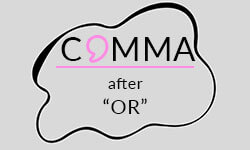
The correct use of commas in academic writing is essential to remain clear and structured and to enable an easier understanding. Having difficulties understanding comma rules is a common problem among students due to the lack of detailed knowledge and quantity of comma rules. In this article, we’ll provide examples, a practice sheet, and explain if you should be using a comma after “or.”
When to place a comma after “or”
The word “or” is a coordinating conjunction used to link alternatives or choices within a sentence. It indicates an option between words, phrases, clauses, or sentences. The use of a comma with “or” depends on the specific context in which it’s used. A comma after “or,” however, is less likely to appear than before it.
Comma
Before an interrupter
After introductory clause
End of parenthetical information
No comma
Simple choices
Short phrases
Coordinate adjectives
Comma rules may vary depending on different Style Guides. In rare cases, a comma after “or” can be used when it stands at the end of a sentence following an interrupter, at the end of a parenthesis, or after an introductory clause that cannot stand on its own.
Comma after “or”
There are three rules for when you use a comma after “or.” Before an interrupter, at the end of parenthetical information and after an introductory clause. They all will be thoroughly explained below.
Before an interrupter
An interrupter in grammar is a word, phrase, or clause that significantly breaks the flow of a sentence to insert additional information, make a side comment, show emotion, or add emphasis, without changing the overall meaning of the sentence.
Commas are typically used before and after interrupters to set them off from the rest of the sentence, indicating a pause for clarity and readability.
Many style guides advise omitting the comma between the conjunction and the introductory element to make the sentence less punctuation-heavy. So a comma, in this case, is optional and not mandatory.
After introductory clause
An introductory clause acts as a clarifying statement about the main sentence. It is usually a dependent statement, which cannot stand alone as a complete sentence because it does not express a complete thought. In this case, an after-comma is necessary to help readers avoid confusion. This phenomenon concerning “or,” however, is very rare. This is only the case, when “or” is used as an example.
End of parenthetical information
Parenthetical information is set apart from the rest of a sentence by parenthesis, commas, or dashes. It would be parenthetical if the information was removed, and this would not change the meaning or grammar of the sentence. Commas are required by default when writing a parenthetical expression within a sentence. This is only the case, when “or” is used as an example, too.
No comma after “or”
We have already talked about “or” being a conjunction. As a conjunction’s purpose is to connect two words, phrases, or clauses that are part of a single thought or choice, there is no need for a pause.
In a high percentage of cases, you do not use a comma after “or,” especially in short or straightforward phrases or when it connects coordinate adjectives. However, you can use a comma before the conjunction, this is also called the Oxford comma.
Simple choices
When “or” connects two simple choices or alternatives within a sentence, a comma is not necessary. These are typically short and straightforward options.
Short phrases
If the phrases following “or” are short and closely related, a comma after is omitted.
Coordinate adjectives
When “or” connects coordinate adjectives (adjectives that modify the same noun), a comma is not used.
Test yourself!
Practice sheet
You can check your understanding of using commas after “or” by taking this test. The correct answers to the 10 sentences can be found in the second tab.
- You can choose to study either chemistry __ physics this semester.
- The experiment requires a control group __ alternatively, a placebo group.
- The mathematician used induction __ deduction to solve the problem.
- Students must submit a thesis __ complete an internship to fulfil the requirements.
- To improve her knowledge of commas after and before __ she practiced the whole day.
- The results are preliminary __ more accurately, inconclusive, at this stage.
- The economy may experience growth __ conversely, a recession.
- You can use qualitative __ quantitative methods for your research.
- The theory suggests a linear progression __ in some cases, a cyclical pattern.
- The study explores cognitive or emotional aspects of decision-making.
- You can choose to study either chemistry or physics this semester. (No Comma)
- The experiment requires a control group, or, alternatively, a placebo group. (Comma)
- The mathematician used induction or deduction to solve the problem. (No Comma)
- Students must submit a thesis or complete an internship to fulfil the requirements. (No Comma)
- To improve her knowledge of commas after and before “or,” she practiced the whole day. (Comma)
- The results are preliminary, or, more accurately, inconclusive, at this stage. (Comma)
- The economy may experience growth or, conversely, a recession. (Comma)
- You can use qualitative or quantitative methods for your research. (No Comma)
- The theory suggests a linear progression, or, in some cases, a cyclical pattern. (Comma)
- The study explores cognitive or emotional aspects of decision-making. (No Comma)
- ✓ Free express delivery
- ✓ Individual embossing
- ✓ Selection of high-quality bindings
FAQs
The Oxford comma is placed before and not after the conjunction “or” in a listing of three or more items.
In very rare cases, such as after an introductory clause, before an interrupter or at the end of a parenthesis, you can use a comma. Usually, Style Guides advise against it, to make a sentence less punctuation-heavy.
